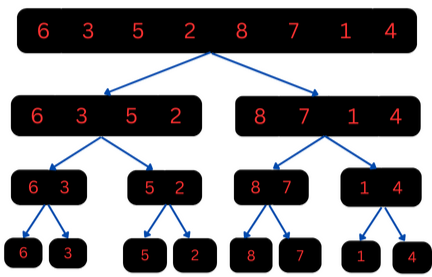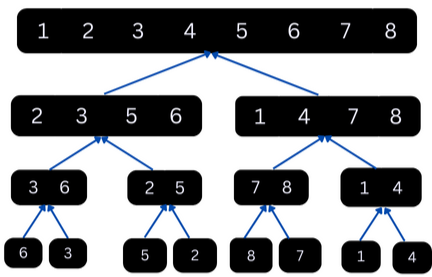merge sort implementation
#merge sort
#the merge algorithm
def merge(L1, L2, L):
i = 0
j = 0
while i+j < len(L):
if j == len(L2) or (i < len(L1) and L1[i] < L2[j]):
L[i+j] = L1[i]
i += 1
else:
L[i+j] = L2[j]
j += 1
#main function
def merge_sort(L):
n = len(L)
if n < 2:
return # list is already sorted
# divide
mid = n // 2 #midpoint
L1 = L[0:mid] # the first half
L2 = L[mid:n] # the second half
# conquer with recursion
merge_sort(L1) # sort first sub-list
merge_sort(L2) # sort second sub-list
# merge result
merge(L1, L2, L)
#example
L = [7, 5, 1, 4, 2, 8, 0, 9, 3, 6]
print('Before: ', L)
merge_sort(L)
print('After: ', L)
The merge sort algorithm uses the divide and conquer technique to efficiently sort a list of elements.
Divide and conquer involves breaking down a larger problem into smaller more manageable sub-problems, solving the sub-problems and then merging their solutions to solve the original problem. In the case with merge-sort, the algorithm breaks down the list into smaller sub-lists, sorts those sub-lists recursively, and then merges the sorted sub-lists back together until the entire list is sorted
Merge sort has time complexity of O(nlogn) in both average and worst case scenarios, this makes it one of the fastest sorting algorithms and consequently, one of the most sought after.
Merge sort is stable, meaning that it preserves the relative order of equal elements in the original list.
Algorithm Description
Assuming we have a list L, the basic steps followed by merge sort are as highlighted below:
- divide - If L has zero or one element, it is already sorted, immediately return L. Otherwise, divide L's elements between two sub-lists, L1 and L2. Where, L1 contains first half of the elements and L2 the rest..
- conquer - Recursively sort sub-lists L1 and L2.
- merge - Combine the elements in a sorted state and put them back to
L.
Example
Consider if we want to sort the following list using merge sort.

In the first step of merge sort, the list will be recursively divided into individual sub-lists. This means that the list will be split into two sub-lists and then each of the sub-lists will be split into two more sub-lists, and so on until each sub-list contains only a single element. The following figure demonstrates the splitting phase:

After the divide step is over, we need to recursively sort each sub-list and then merge it with the other sorted sub-lists. This is known as the "conquer" step.
The conquer step can be visualized as starting from the bottom level moving upwards, sorting and combining the sub-lists at each level until the entire list is sorted.

As shown in the above figure, at the beginning of the conquer step(at the bottom level), each sub-list is made up of a single element. Logically, a list with only one element is already sorted. Sub-lists with more than a single elements in upper levels are first sorted before they are merged with the other sub-lists.
Merge sort implementation
In this section, we will implement the merge sort algorithm using functions.
For the sake of clarity, we will split the algorithm into two functions, merge() and merge_sort(). The merge() function will be responsible for combining two already sorted sub-lists into a single sorted list. The merge_sort() function is where the main logic of the algorithm will go.
The merge() function
#L is the list while L1 and L2 are the sublists.
def merge(L1, L2, L):
i = j = 0
while i+j < len(L):
if j == len(L2) or (i < len(L1) and L1[i] < L2[j]):
L[i+j] = L1[i]
i += 1
else:
L[i+j] = L2[j]
j += 1
#example
L = [2, 7, 4, 0, 6, 5]
L1 = [2, 4, 7]
L2 = [0, 6, 5]
merge(L1, L2, L)
print(L)The merge() function above takes in two sorted sub-lists(L1 and L2) and puts their elements back to the original list(L) in a sorted state. It does so by determining from which sub-list the next item should be taken before inserting the picked item back to list L. For clarity, let us look at the function statement by statement:
i = j = 0- This statement initializes two distinct variables,iandjeach with a value of0. The two variablesi, andjrepresents the position of the current element inL1andL2, respectively.while i+j < len(L):- Loop until the value ofi + jis greater than the length of the list. Note that at this point, the merge operation will be complete.if j == len(L2) or (i < len(L1) and L1[i] < L2[j]):
L[i+j] = L1[i]
i += 1
else:
L[i+j] = L2[j]
j += 1
-Thej == len(L2)condition checks if there is elements to be picked inL2, remember thatjrepresents the position of the current element inL2, thus if it is equal tolen(L2), it means that we have reached the end ofL2, so we pick the next element fromL1and insert it toL.
-Due to the presence ofor, the second condition i.e(i < len(L1) and L1[i] < L2[j])will only be tested if the first condition, i.e(j == len(L2))fails, it means thatL2still has element . So we pick and insert intoLthe smaller of the sub-lists' current element and then increment eitheriorjdepending on whose sub-list's element was picked.
-Theelsestatement also caters for whenL1has no more elements.
After implementing the merge() function, the implementation of the merge_sort() function become easier.
implement merge_sort()
#the implementation of merge() is omitted, refer to the previous snippet.
def merge_sort(L):
n = len(L)
if n < 2:
return # list is already sorted
# divide
mid = n // 2 #midpoint
L1 = L[0:mid] # the first half
L2 = L[mid:n] # the second half
# conquer
merge_sort(L1) # recursively sort first sub-list
merge_sort(L2) # recursively sort second sub-list
# merge
merge(L1, L2, L)
#usage example
L = [99, 9, 0, 2, 1, 0, 1, 100, -2, 8, 7, 4, 3, 2]
merge_sort(L)
print(L)[-2, 0, 0, 1, 1, 2, 2, 3, 4, 7, 8, 9, 99, 100]
The merge_sort() function does not return any value because the sorting happens to the original list.
The entire merge sort implementation is as shown below:
#merge sort implementation
def merge(L1, L2, L):
i = 0
j = 0
while i+j < len(L):
if j == len(L2) or (i < len(L1) and L1[i] < L2[j]):
L[i+j] = L1[i]
i += 1
else:
L[i+j] = L2[j]
j += 1
def merge_sort(L):
n = len(L)
if n < 2:
return # list is already sorted
# divide
mid = n // 2 #midpoint
L1 = L[0:mid] # the first half
L2 = L[mid:n] # the second half
# conquer with recursion
merge_sort(L1) # sort first sub-list
merge_sort(L2) # sort second sub-list
# merge result
merge(L1, L2, L)
#usage example
L = [99, 9, 0, 2, 1, 0, 1, 100, -2, 8, 7, 4, 3, 2]
merge_sort(L)
print(L)Complexity analysis
The time complexities of merge sort with a list of size n, are as outlined below:
- Best case -
O(nlogn) , this happens when the input list is already sorted. - Average case -
O(nlogn), when the input list is randomly sorted. - Worst case -
O(nlogn), when the input list is reverse sorted.
Space complexity
Merge sort has a space complexity of O(n) due to the space occupied by the sub-lists.
